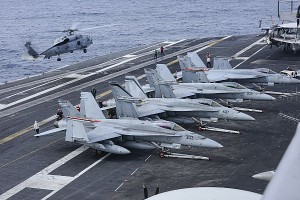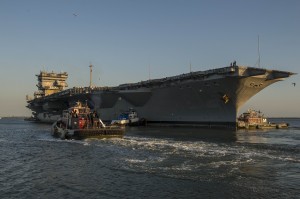 Over on the excellent Navy Matters Blog there’s a little bit of a low-grade panic brewing up over the apparent mismatch of an “eleven carrier fleet” with only nine carrier air wings.
Over on the excellent Navy Matters Blog there’s a little bit of a low-grade panic brewing up over the apparent mismatch of an “eleven carrier fleet” with only nine carrier air wings.
Dastardly things are afoot, it seems.
With one member of the “eleven-carrier fleet” constantly committed to a three-year refueling/refit cycle, the fear is that the tenth carrier lacks aircraft and is redundant–at real risk of being cut! Thus, an early CVN retirement is inevitable! (Cue gnashing of teeth from their blog readers and some gratuitous bad-mouthing of current naval leadership).
I mean….it’s hype only the Aircraft Carrier Industrial Base Coalition could love!
Sigh. Look. There’s not some illuminati-like Navy scheme afoot to cut a carrier (Compared with the Navy’s years-long effort to “shed” the Captain-killing USS Cowpens (CG-63)– which, it seems, has finally succeeded,–the Navy appears eager to let a lot of other ships go before they even think about mothballing a CVN). A perceived air wing shortage is not an indicator of an early CVN retirement. (Another round of sequestration, on the other hand, might well be the harbinger of a far smaller carrier fleet…)
But Air Wings? A shortfall? The numbers don’t add up.
Look at the fleet today–right now we have seven carriers that are active: CVN-68, CVN-70, CVN-71, CVN-73, CVN-74, CVN-75 and CVN-77. The inactive CVN-69 is expected to come out of an almost 17 month refit in February 2015. Inactive CVN-72 is refueling and won’t be in service until November 2016 at the earliest. CVN-76 is out for a Planned Incremental Availability until April of 2015. CVN-78 won’t commission until 2017. And a few of those active carriers are set for maintenance in the interim as well.
But that leaves America with seven carriers that could, with some warning, spin up and get on station pretty fast. That’s it. So…I think Navy Matter’s fear is misplaced. With only seven carriers available, I’d worry more about the Navy killing off a superfluous air wing!
 Levity aside, the current debate about the size of the aircraft carrier fleet really does a poor job of explaining the amount of time CVNs spend in the shipyard. If anything, CVN supporters minimize the impact of maintenance. I’m glad the Aircraft Carrier Industrial Base Coalition is trying to explain the mid-life refueling process. It is a start. But a three-year mid-life refueling is just the longest, most expensive downtime in a CVN’s long service life. Observers–along with policymakers–often forget about the four, oh, 9-17+ month Drydocking Planned Incremental Availabilities and the 12 5-7+ month Planned Incremental Availabilities that a Nimitz Class Carrier endures over 50 years of service.
Levity aside, the current debate about the size of the aircraft carrier fleet really does a poor job of explaining the amount of time CVNs spend in the shipyard. If anything, CVN supporters minimize the impact of maintenance. I’m glad the Aircraft Carrier Industrial Base Coalition is trying to explain the mid-life refueling process. It is a start. But a three-year mid-life refueling is just the longest, most expensive downtime in a CVN’s long service life. Observers–along with policymakers–often forget about the four, oh, 9-17+ month Drydocking Planned Incremental Availabilities and the 12 5-7+ month Planned Incremental Availabilities that a Nimitz Class Carrier endures over 50 years of service.
Maintenance is important. CVN supporters may squirm a bit when taxpayers realize just how much time a CVN needs to spend in the “shop”, but that’s probably going to be offset by the taxpayer’s concern that the “11 Carrier Fleet” is really a seven carrier fleet…or less. The average taxpayer (or Congressman or fledgling NSC member) doesn’t realize that the Navy can surge a carrier forward from training, but cutting a DPIA or PIA short in a pinch–for those fast fights of the future–is almost impossible.
I am sure some will disagree. But to me, these days, when a carrier is in the shipyard, it’s out of action. And let me tell ya–the harder the U.S. Navy uses the carriers and the less time the Navy invests in preventative maintenance, the longer these availabilities are going to become. American carriers have a great reputation because they’ve been maintained well. But things seem to be changing now that the money is short; despite all the happy Fleet Forces talk about a “Readiness Kill Chain” (whatever that powerpoint glop of operations analysis run amok actually was), the overly long CVN-69 refit is, I fear, a template for the future.
CVN maintenance is ultimately a fleet size issue.
My sense is that any carrier (or, for that matter, any other ship) that is in planned maintenance for over a year should be removed from the Naval Vessel Register’s list of Ship Battle Forces (Keep the Commissioned Fleet list the same, but I think the Ship Battle Forces should be somewhat fluid–updated maybe on a quarterly basis).
But reinforcing the idea that ships in refit aren’t available for battle would be helpful for American policymakers to more accurately describe the true size–and measurable power–of the U.S. fleet.

{ 3 comments… read them below or add one }
Effectively, there’s only half as many aircraft in the Navy’s inventory
as they need to fill a full carrier air wing for each Aircraft Carrier as it is. I remember back when that Iranian drone flew over a US Carrier in the Persian Gulf, it was noted that the big flattops seldom went to sea with more than 40 aircraft, and they were down for maintenance most of the time.
Interestingly, that harkens back to the CVV “Medium” Aircraft Carrier proposal of the late 1970s, which was meant to carry a simililar number of aircraft;
http://en.wikipedia.org/wiki/Aircraft_Carrier_%28Medium%29
http://i22.photobucket.com/albums/b336/Bager1968/Carriers/USN%20Midway%20and%20Essex%20CV/CVVb.jpg
We could have had the same number of Carriers in the water, carrying the same number of aircraft, for only a fraction of the price — and without the dangers or stigmata of nuclear power.
The Navy has always had roughly a third of the fleet in for repairs at any given time. Also, the air wings are in about the same shape; when carriers go into the yards, their aircraft go into a stand-down status. An aircraft squadron in maintenance phase is lucky to have half its planes flyable, so there really isn’t fat to cut there.
Good points guys.